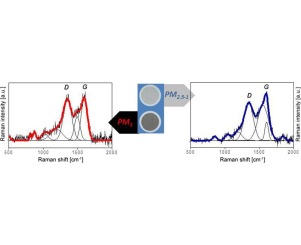Particuology ( IF 4.1 ) Pub Date : 2017-07-18 , DOI: 10.1016/j.partic.2017.05.001 Issariya Vejpongsa , Sirikalaya Suvachittanont , Natsuda Klinklan , Thunyapat Thongyen , Miklos Veres , Wladyslaw W. Szymanski

|
Urban ambient aerosols in the size range below 10 μm were measured and sampled for further evaluation (by Raman and Thermal-Optical analysis) of the collected material. The presented data shows that monitoring number and/or surface area concentrations besides the mass concentration provides valuable information for a meaningful assessment of the actual ambient air quality. The aim of the study was to characterize the urban aerosols using various instruments, methods, and sampling conditions, and to determine whether a split of the PM2.5 size fraction at PM1 may deliver a more sensible indication of the actual air quality than the current standard of monitoring PM2.5. We found substantial differences relating to this split. PM2.5 data frequently include particles from both mechanical and combustion processes. PM1 measurements can be used to better distinguish particles derived from these two sources. We measured number concentrations of PM1 with PM2.5–1 concurrently with particle mass concentration and found that the typical average particle diameter by mass in the urban aerosols investigated was in the range of 120 nm; this corresponded well with the particle number size distributions measured in real time. Raman spectral analysis and thermal-optical evaluation of the sampled material also suggested that it would be sensible to split the measurement of the PM2.5 fraction into PM1 and PM2.5–1 size fractions, especially for analysis of carbonaceous aerosol components using the DRI thermal/optical reflectance carbon analysis system
中文翻译:

根据泰国曼谷城市气溶胶的综合特征,将PM 1和PM 2.5作为空气质量指标进行审议
对尺寸在10μm以下的城市环境气溶胶进行了测量和采样,以进一步评估(通过拉曼光谱和热光分析)收集到的材料。呈现的数据表明,除了质量浓度外,监测数量和/或表面积浓度还可以提供有价值的信息,以对实际环境空气质量进行有意义的评估。这项研究的目的是使用各种仪器,方法和采样条件来表征城市气溶胶,并确定在1号PM处PM 2.5尺寸分数的分离是否可以比当前的空气质量更合理地指示实际空气质量。监测PM 2.5的标准。我们发现与此拆分相关的实质性差异。下午2.5数据经常包括来自机械过程和燃烧过程的颗粒。PM 1测量值可用于更好地区分源自这两个来源的颗粒。我们同时测量了PM 1和PM 2.5-1的数量浓度以及颗粒质量浓度,发现所研究的城市气溶胶的质量平均典型粒径在120 nm范围内。这与实时测量的颗粒数大小分布非常吻合。拉曼光谱分析和样品的热光评估还表明,将PM 2.5组分的测量分为PM 1和PM 2.5–1是明智的。 尺寸分数,特别是使用DRI热/光反射碳分析系统分析碳质气溶胶成分时











































 京公网安备 11010802027423号
京公网安备 11010802027423号